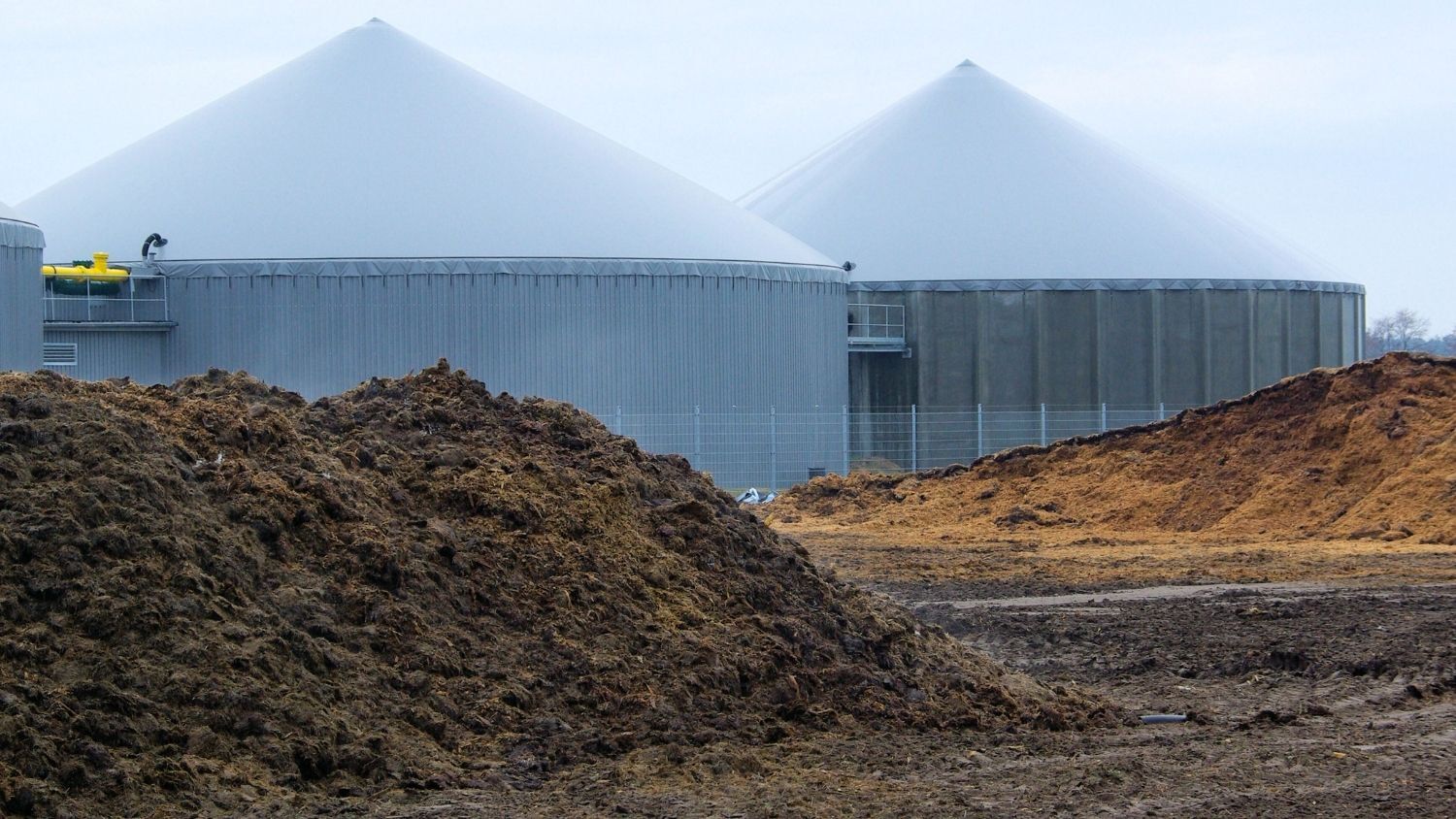While 2020 sure wasn't an easy year, we too had our ups and downs. This newsletter we thus dedicate to a recap of this year and to an outlook of what's to come.
Probably every newsletter around this time of the year will start with Covid-19, so we won't go down this route.
Growing head count
In 2020, we welcomed 4 new persons on our team: Claudio Reale, Oliver Maurer and, 4 days ago, on the last day of 2020, Charles Toft. All these people are professionals in their own fields, from production to engineering and - of course - metal-organic frameworks.
Nonetheless, we also lost our former MOF-brain Gerald Bauer to Climeworks, a startup dedicated to reversing climate change by capturing CO2 from the atmosphere.

Increasing production
Luckily, most of us are working from home at the moment, as we are expanding our production area and the construction isn't noise-free. Walls are removed to make space for workup equipment and the next synthesis line in the future. In January, we should receive new equipment and the rooms are hopefully fully refurbished until then.
The year 2020 for MOFs
MOFs are increasingly known outside of academia, and the interest in the application of these advanced materials is rising too. At the same time, we have noticed a stronger reduction of publications on the topic compared to previous years. This could be attributed to the pandemic, but it could also indicate that research is turning more application-focused.
We have seen an increase of interest from companies in oil&gas, medical devices, near-food and HVAC. And multiple large-scale projects are lined up for next year.
2021 and MOFs
For the upcoming year, we expect more applied research and the combination of MOFs with other materials to increase performance and stability for real-world applications.
For novoMOF, we expect more projects en route to the first commercial prototypes and demonstrators. There is still work to be done and we are charging into new projects to bring these fantastic materials to the use in our everyday life.
Covid-19
Yes, we need to mention it - but mostly in a positive way. While Covid-19 didn't have a direct impact on the team (no one caught it, yes!), we have changed how we work to mostly remote office. Only the bare minimum of people visit the office if need be, mainly our lab and production staff. Everyone else works from home. This does have it's pros and cons, and we do miss going for lunch or an afterwork drink together.
However, we have also seen that many companies are increasingly use this time to discover new materials and jump into projects with us. And thus we are working on many new projects, and with many new partners worldwide.
And we are working towards great news to fight the disease. Stay tuned!
From our blog
New articles of the last quarter
More power from solar panels – by using porous materials
 Solar cells are considered one of the most promising technologies for energy harvesting direct from sunlight aiming to replace fossil fuels. Recently, Metal-Organic Frameworks (MOFs) have raised as promising materials to enhance the performance and stability of solar cells.
Solar cells are considered one of the most promising technologies for energy harvesting direct from sunlight aiming to replace fossil fuels. Recently, Metal-Organic Frameworks (MOFs) have raised as promising materials to enhance the performance and stability of solar cells.
Interesting publications
We have categorised the publications and news in the following sections (click to skip to the section):
- Publications related to MOF-based batteries
- Gas separations
- Pharmaceuticals / biomedical
- Toxic gas
- Sensors
- Other publications
Here are the other newsletter-articles from this year with more interesting publications:
Metal–Organic Frameworks: Molecular‐Scale Interface Engineering of Metal–Organic Frameworks toward Ion Transport Enables High‐Performance Solid Lithium Metal Battery
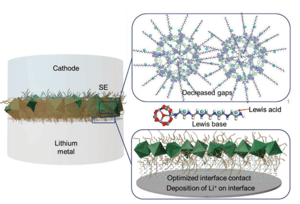 Metal–organic frameworks (MOFs) have drawn considerable interest as solid electrolytes (SEs) by virtue of their talents for rational design as ion channels. The crystal interface plays a significant role in ion transport and is thus of vital importance to the performance of solid batteries, however, interface effects of MOFs in SEs are not yet fully understood, especially at the molecular level, and not engineered as well. In this work, MOFs engineered with diverse molecules (Lewis bases) are designed for an optimized interfaces and the impact of interfaces for ion transport is analyzed by using engineered MOFs as SEs. The results show that the ion conductivity of MOFs decorated with a long chain Lewis base (LCLB) has been greatly improved. The interface resistance of the SEs composed of MOFs with LCLB has decreased markedly. Most importantly, the corresponding Li|SE|LiPO4 solid‐state battery (SSB) shows an improved specific capacity of 47% and longer lifetime at 5 C compared with the SSB without interface engineering. Such results shed new light on the understanding of ion transport at interfaces and suggest the feasibility of interface engineered MOFs as advanced SEs.
Metal–organic frameworks (MOFs) have drawn considerable interest as solid electrolytes (SEs) by virtue of their talents for rational design as ion channels. The crystal interface plays a significant role in ion transport and is thus of vital importance to the performance of solid batteries, however, interface effects of MOFs in SEs are not yet fully understood, especially at the molecular level, and not engineered as well. In this work, MOFs engineered with diverse molecules (Lewis bases) are designed for an optimized interfaces and the impact of interfaces for ion transport is analyzed by using engineered MOFs as SEs. The results show that the ion conductivity of MOFs decorated with a long chain Lewis base (LCLB) has been greatly improved. The interface resistance of the SEs composed of MOFs with LCLB has decreased markedly. Most importantly, the corresponding Li|SE|LiPO4 solid‐state battery (SSB) shows an improved specific capacity of 47% and longer lifetime at 5 C compared with the SSB without interface engineering. Such results shed new light on the understanding of ion transport at interfaces and suggest the feasibility of interface engineered MOFs as advanced SEs.
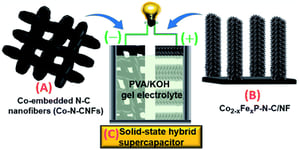 In recent years, much effort has been devoted to developing hybrid supercapacitors due to their capability to deliver both high energy and power density. The hybrid approach is advantageous in terms of reinforcing the synergic combination of the properties of different components in a hybrid composite. However, a large kinetic mismatch existing between the fast capacitive and sluggish battery-type electrodes greatly hinders its advancement. In this work, we report the fabrication of a solid-state hybrid supercapacitor (SSHSC) device using metal–organic framework (MOF)-derived cobalt-embedded N-doped carbon nanofibers (Co–N-CNFs) and Co2−xFexP–N–C micropillar arrays grown on Ni foam (Co2−xFexP–N–C/NF) as multi-component hybrid electrodes with improved charge storage kinetics. Such Co–N-CNFs (negative electrode) exhibited a remarkable specific capacitance of 280 F g−1 at a current density of 1 A g−1, while Co2−xFexP–N–C/NF (positive electrode) exhibited a high specific capacity of 345 mA h g−1 at a current density of 1 A g−1 due to the synergistic combinations of different components in a single hybrid composite. The assembled Co2−xFexP–N–C/NF(+)//Co–N-CNFs(−) SSHSC device demonstrated a high specific capacity of 104 mA h g−1 at a current density of 1 A g−1 with a maximum energy density of 84.7 W h kg−1 at a power density of 706 W kg−1. It also exhibited excellent stability and reversibility with a capacity retention of 93% and coulombic efficiency of 99.6% after 10 000 galvanostatic charge–discharge (GCD) cycles. Two SSHSC devices connected in series after being charged could easily light up a red LED bulb. These excellent performances indicate that Co–N-CNFs(−) and Co2−xFexP–N–C/NF(+) materials could be considered as potential electrodes for high energy density storage systems.
In recent years, much effort has been devoted to developing hybrid supercapacitors due to their capability to deliver both high energy and power density. The hybrid approach is advantageous in terms of reinforcing the synergic combination of the properties of different components in a hybrid composite. However, a large kinetic mismatch existing between the fast capacitive and sluggish battery-type electrodes greatly hinders its advancement. In this work, we report the fabrication of a solid-state hybrid supercapacitor (SSHSC) device using metal–organic framework (MOF)-derived cobalt-embedded N-doped carbon nanofibers (Co–N-CNFs) and Co2−xFexP–N–C micropillar arrays grown on Ni foam (Co2−xFexP–N–C/NF) as multi-component hybrid electrodes with improved charge storage kinetics. Such Co–N-CNFs (negative electrode) exhibited a remarkable specific capacitance of 280 F g−1 at a current density of 1 A g−1, while Co2−xFexP–N–C/NF (positive electrode) exhibited a high specific capacity of 345 mA h g−1 at a current density of 1 A g−1 due to the synergistic combinations of different components in a single hybrid composite. The assembled Co2−xFexP–N–C/NF(+)//Co–N-CNFs(−) SSHSC device demonstrated a high specific capacity of 104 mA h g−1 at a current density of 1 A g−1 with a maximum energy density of 84.7 W h kg−1 at a power density of 706 W kg−1. It also exhibited excellent stability and reversibility with a capacity retention of 93% and coulombic efficiency of 99.6% after 10 000 galvanostatic charge–discharge (GCD) cycles. Two SSHSC devices connected in series after being charged could easily light up a red LED bulb. These excellent performances indicate that Co–N-CNFs(−) and Co2−xFexP–N–C/NF(+) materials could be considered as potential electrodes for high energy density storage systems.
Metal−Organic Framework Based PVDF Separators for High Rate Cycling Lithium-Ion Batteries
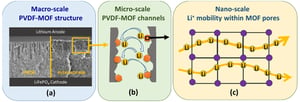 Poly(vinylidene fluoride) (PVDF) and MOF-808-based separators for lithium-ion batteries (LIBs) have been prepared and fully characterized in terms of morphological and thermal properties, electrolyte uptake, and retention, and surface hydrophilic characteristics. The effect of PVDF/MOF-808 separators on the electrochemical performance of LIBs has been evaluated. The PVDF/MOF-808 membranes exhibit a well-defined porous structure with a uniform distribution of interconnected macro- to mesopores. The inclusion of the Zr-based MOF nanoparticles increases the porosity and surface area of the separator, enhancing the electrolyte uptake and the ionic conductivity. Finally, the presence of MOF-808 fillers improves the liquid electrolyte retention, which prevents the capacity fading at high C-rates cycling. Indeed, charge–discharge tests performed in Li/C-LiFePO4 half-cells reveal a discharge capacity of 68 mAh·.g–1 at 2C-rate for PVDF/MOF-808 membranes, in comparison with the 0 mAh·g–1 obtained for pure PVDF. The PVDF/10 wt % MOF-808 sample shows a long-term stable cycling behavior with a Coulombic efficiency close to 100%. Thus, it is shown that the composite membranes represent an improvement with respect to conventional separators for lithium ion battery applications, since they coupled the polymer meso- and macroporous structure with the well-ordered microporous system of the MOFs, which improve significantly the electrolyte affinity.
Poly(vinylidene fluoride) (PVDF) and MOF-808-based separators for lithium-ion batteries (LIBs) have been prepared and fully characterized in terms of morphological and thermal properties, electrolyte uptake, and retention, and surface hydrophilic characteristics. The effect of PVDF/MOF-808 separators on the electrochemical performance of LIBs has been evaluated. The PVDF/MOF-808 membranes exhibit a well-defined porous structure with a uniform distribution of interconnected macro- to mesopores. The inclusion of the Zr-based MOF nanoparticles increases the porosity and surface area of the separator, enhancing the electrolyte uptake and the ionic conductivity. Finally, the presence of MOF-808 fillers improves the liquid electrolyte retention, which prevents the capacity fading at high C-rates cycling. Indeed, charge–discharge tests performed in Li/C-LiFePO4 half-cells reveal a discharge capacity of 68 mAh·.g–1 at 2C-rate for PVDF/MOF-808 membranes, in comparison with the 0 mAh·g–1 obtained for pure PVDF. The PVDF/10 wt % MOF-808 sample shows a long-term stable cycling behavior with a Coulombic efficiency close to 100%. Thus, it is shown that the composite membranes represent an improvement with respect to conventional separators for lithium ion battery applications, since they coupled the polymer meso- and macroporous structure with the well-ordered microporous system of the MOFs, which improve significantly the electrolyte affinity.
Metal–Organic Framework/Polyaniline Nanocomposites for Lightweight Energy Storage
We describe a simple strategy to modify zeolitic imidazolate framework-8 (ZIF-8) using polyaniline (PANI) via a controlled interfacial polymerization method, without using a template, to synthesize ZIF-8/PANI nanocomposites. Our method avoids the agglomeration of ZIF-8/PANI, boosts the utilization of active materials, and exposes more active sites, and hence, it is advantageous to facile electron transfer. Because of its unique hierarchical structure, ZIF-8/PANI has a high surface area (610.8 m2·g–1) and the ZIF-8/PANI electrode exhibited a capacitance value of 395.4 F·g–1 at 0.2 A·g–1, which is the highest among the metal–organic framework (MOF)-based composites reported to date. A solid-state asymmetric supercapacitor (SASC) fabricated with ZIF-8/PANI as the electrode showed good capacitive behavior over a wide potential window from 0 to 2.5 V without nonaqueous electrolytes. It exhibited a specific areal capacitance of 28.1 mF·cm–2 at 0.1 mA·cm–2, which is much higher than the values reported for other MOF-based supercapacitors. The SASC also possessed a high energy density (3.2 μW h·cm–2) and power density (1.1 mW·cm–2), good cycling stability, and flexibility. These characteristics make our ZIF-8/PANI nanocomposite an excellent MOF-based electrode for highly flexible and lightweight energy storage applications.
Gas separation/storage and degradation
Hydrocarbon Separation: Designer Metal–Organic Frameworks for Size‐Exclusion‐Based Hydrocarbon Separations: Progress and Challenges
The separation of hydrocarbons is of primary importance in the petrochemical industry but remains a challenging process. Hydrocarbon separations have traditionally relied predominantly on costly and energy‐intensive heat‐driven procedures such as low‐temperature distillations. Adsorptive separation based on porous solids represents an alternative technology that is potentially more energy efficient for the separation of some hydrocarbons. Great efforts have been made recently not only in the development of adsorbents with optimal separation performance but also toward the subsequent implementation of adsorption‐based separation technology. Emerging as a relatively new class of multifunctional porous materials, metal–organic frameworks (MOFs) hold substantial promise as adsorbents for highly efficient separation of hydrocarbons. This is because of their exceptional and intrinsic porosity tunability, which enables size‐exclusion‐based separations that render the highest possible separation selectivity. In this review, recent advances in the development of MOFs for separation of selected groups of hydrocarbons are reviewed, including methane/C2 hydrocarbons, normal alkanes, alkane isomers, and alkane/alkene/alkyne and C8 alkylaromatics, with a particular focus on separations based on the size‐exclusion mechanism. Insights into tailor‐made structures, material design strategies, and structure–property relationships will be elucidated. In addition, the existing challenges and possible future directions of this important research field will be discussed.
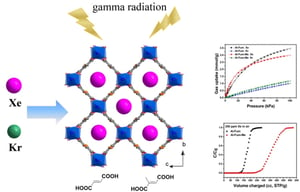 The design and construction of radioactive stable metal–organic frameworks (MOFs) are highly desirable for noble gases (Xe and Kr) separation from off-gas steams during used nuclear fuel reprocessing under radiation environments. Al-based MOFs are promising for realistic applications of Xe/Kr separation due to their high hydrothermal and chemical stability and comparatively easy and massive preparation by nonpoisonous, abundant, and cheap metal. Herein, we report on two isoreticular microporous Al-MOFs Al-Fum (Al-fumarate, Basolite A520) and Al-Fum-Me (Al-methyl-fumarate) with high radioactive stability for Xe/Kr separation. Appending methyl groups on the framework provides an effective approach to reduce and fine-tune the pore size of Al-Fum-Me to match well with the Xe atom and remarkably improve the framework-Xe affinity. Al-Fum-Me exhibits significantly enhanced Xe/Kr separation performance compared to Al-Fum, demonstrated by adsorption isotherms and breakthrough experiments. Gamma-ray irradiation experiments also identified the high radioactive stability of Al-Fum-Me, suggesting its great potential for practical application on Xe/Kr separation.
The design and construction of radioactive stable metal–organic frameworks (MOFs) are highly desirable for noble gases (Xe and Kr) separation from off-gas steams during used nuclear fuel reprocessing under radiation environments. Al-based MOFs are promising for realistic applications of Xe/Kr separation due to their high hydrothermal and chemical stability and comparatively easy and massive preparation by nonpoisonous, abundant, and cheap metal. Herein, we report on two isoreticular microporous Al-MOFs Al-Fum (Al-fumarate, Basolite A520) and Al-Fum-Me (Al-methyl-fumarate) with high radioactive stability for Xe/Kr separation. Appending methyl groups on the framework provides an effective approach to reduce and fine-tune the pore size of Al-Fum-Me to match well with the Xe atom and remarkably improve the framework-Xe affinity. Al-Fum-Me exhibits significantly enhanced Xe/Kr separation performance compared to Al-Fum, demonstrated by adsorption isotherms and breakthrough experiments. Gamma-ray irradiation experiments also identified the high radioactive stability of Al-Fum-Me, suggesting its great potential for practical application on Xe/Kr separation.High Ammonia Uptake of a Metal–Organic Framework Adsorbent in a Wide Pressure Range
3D printing of metal–organic framework incorporated porous scaffolds to promote osteogenic differentiation and bone regeneration
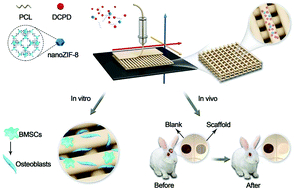 Bone substitute biomaterials, whose compositions and structures both play vital roles in bone defect healing, hold promising prospects in the clinical treatment of bone defects. Three-dimensional (3D) printed porous scaffolds incorporating osteoinductive components are considered as ideal bone grafts, because of the accurate control of structure parameters and the capacity to enhance bone tissue regeneration. Our previous studies demonstrated that nanoscale zeolitic imidazolate framework-8 (nanoZIF-8), a subclass of metal organic frameworks (MOFs), presented minimal cytotoxicity, inhibited bacterial activities, and promoted osteogenesis both in vitro and in vivo. However, the application of nanoZIF-8 in the 3D printed scaffold system remains unknown. In this study, nanoZIF-8 was incorporated into composite scaffolds composed of polycaprolactone (PCL) and dicalcium phosphate dihydrate (DCPD) via extrusion-based 3D printing technology. The results revealed that the composite scaffolds possessed increased mechanical strength and exhibited homogeneous structure with highly interconnected macropores. In vitro studies indicated that scaffolds showed biocompatibility to bone mesenchymal stem cells (BMSCs), significantly up-regulated the expression of osteogenesis-related genes and proteins, and facilitated the extracellular matrix mineralization. In vivo results showed that 3D printed porous scaffolds promoted new bone formation and enhanced micro-architecture at the critical defect sites (Φ10 mm) in rabbits, compared with the blank control group. Moreover, composite scaffolds significantly improved calvarial defect healing in comparison with scaffolds without nanoZIF-8 incorporation. In summary, nanoZIF-8 modified 3D printed porous composite scaffolds demonstrated great potential in the treatment of critical-sized bone defects, proving the effectiveness of MOF incorporation in 3D printed composite scaffolds to promote osteogenesis in the field of bone tissue engineering.
Bone substitute biomaterials, whose compositions and structures both play vital roles in bone defect healing, hold promising prospects in the clinical treatment of bone defects. Three-dimensional (3D) printed porous scaffolds incorporating osteoinductive components are considered as ideal bone grafts, because of the accurate control of structure parameters and the capacity to enhance bone tissue regeneration. Our previous studies demonstrated that nanoscale zeolitic imidazolate framework-8 (nanoZIF-8), a subclass of metal organic frameworks (MOFs), presented minimal cytotoxicity, inhibited bacterial activities, and promoted osteogenesis both in vitro and in vivo. However, the application of nanoZIF-8 in the 3D printed scaffold system remains unknown. In this study, nanoZIF-8 was incorporated into composite scaffolds composed of polycaprolactone (PCL) and dicalcium phosphate dihydrate (DCPD) via extrusion-based 3D printing technology. The results revealed that the composite scaffolds possessed increased mechanical strength and exhibited homogeneous structure with highly interconnected macropores. In vitro studies indicated that scaffolds showed biocompatibility to bone mesenchymal stem cells (BMSCs), significantly up-regulated the expression of osteogenesis-related genes and proteins, and facilitated the extracellular matrix mineralization. In vivo results showed that 3D printed porous scaffolds promoted new bone formation and enhanced micro-architecture at the critical defect sites (Φ10 mm) in rabbits, compared with the blank control group. Moreover, composite scaffolds significantly improved calvarial defect healing in comparison with scaffolds without nanoZIF-8 incorporation. In summary, nanoZIF-8 modified 3D printed porous composite scaffolds demonstrated great potential in the treatment of critical-sized bone defects, proving the effectiveness of MOF incorporation in 3D printed composite scaffolds to promote osteogenesis in the field of bone tissue engineering.
An enantioselective e‐nose: An array of nanoporous homochiral MOF films for stereospecific sensing of chiral odors
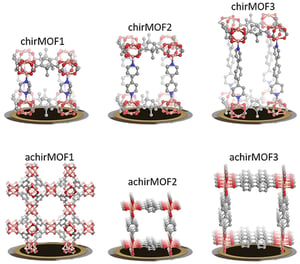 Chirality is essential in nature and often pivotal for biological information transfer, for example, via odor messenger molecules. While the human nose can distinguish the enantiomers of many chiral odors, the technical realization by an artificial sensor or an electronic nose, e‐nose, remains a challenge. Herein, we present an array of six sensors coated with nanoporous metal–organic framework (MOF) films of different homochiral and achiral structures, working as an enantioselective e‐nose. While the achiral‐MOF‐film sensors show identical responses for both isomers of one chiral odor molecule, the responses of the homochiral MOF films differ for different enantiomers. By machine learning algorithms, the combined array data allow the stereoselective identification of all compounds, here tested for five pairs of chiral odor molecules. We foresee the chiral‐MOF‐e‐nose, able to enantioselectively detect and discriminate chiral odors, to be a powerful approach towards advanced odor sensing.
Chirality is essential in nature and often pivotal for biological information transfer, for example, via odor messenger molecules. While the human nose can distinguish the enantiomers of many chiral odors, the technical realization by an artificial sensor or an electronic nose, e‐nose, remains a challenge. Herein, we present an array of six sensors coated with nanoporous metal–organic framework (MOF) films of different homochiral and achiral structures, working as an enantioselective e‐nose. While the achiral‐MOF‐film sensors show identical responses for both isomers of one chiral odor molecule, the responses of the homochiral MOF films differ for different enantiomers. By machine learning algorithms, the combined array data allow the stereoselective identification of all compounds, here tested for five pairs of chiral odor molecules. We foresee the chiral‐MOF‐e‐nose, able to enantioselectively detect and discriminate chiral odors, to be a powerful approach towards advanced odor sensing.
Metal–organic frameworks: a future toolbox for biomedicine?
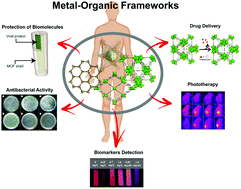 The present review focuses on the use of Metal–Organic Frameworks, (MOFs) highlighting the most recent developments in the biological field. This review assesses, in the first instance, the cytotoxicity of MOFs (particularly those used for various biological applications described throughout this review), and shows that for standard MOFs based on metals already present in active molecules of the human body, toxicity is not a significant limitation. Here we underline the MIL-, UiO- and ZIF-series of MOFs which remain until now the most used materials in drug delivery of active pharmaceutical ingredients (APIs), such as antitumourals or retroviral drugs (with high loading and slow release time). Porosity remains undoubtedly the most studied key property of MOFs, that allows the protection of active biomolecules such as enzymes or the development of antimicrobial materials. Emphasis is given on the usage of MOFs for the detection of biomarkers in biological fluids such as urine and blood (detection of cystinuria, identification of penicillin anaphylaxis, urea, bilirubin, biomarkers related to human intoxication, tumoural indicators, among several others), for which a number of simple devices (such as paper strips) were developed. Despite the remarkable and promising results presented in recent years, the literature remains scarce (mostly non-existent) in terms of direct comparison of these novel technologies with the solutions presently available in the market. Action on this side may make the difference in the next years concerning research on MOFs, to see if some of these materials may reach the end-user as new and more efficient treatments or detection approaches.
The present review focuses on the use of Metal–Organic Frameworks, (MOFs) highlighting the most recent developments in the biological field. This review assesses, in the first instance, the cytotoxicity of MOFs (particularly those used for various biological applications described throughout this review), and shows that for standard MOFs based on metals already present in active molecules of the human body, toxicity is not a significant limitation. Here we underline the MIL-, UiO- and ZIF-series of MOFs which remain until now the most used materials in drug delivery of active pharmaceutical ingredients (APIs), such as antitumourals or retroviral drugs (with high loading and slow release time). Porosity remains undoubtedly the most studied key property of MOFs, that allows the protection of active biomolecules such as enzymes or the development of antimicrobial materials. Emphasis is given on the usage of MOFs for the detection of biomarkers in biological fluids such as urine and blood (detection of cystinuria, identification of penicillin anaphylaxis, urea, bilirubin, biomarkers related to human intoxication, tumoural indicators, among several others), for which a number of simple devices (such as paper strips) were developed. Despite the remarkable and promising results presented in recent years, the literature remains scarce (mostly non-existent) in terms of direct comparison of these novel technologies with the solutions presently available in the market. Action on this side may make the difference in the next years concerning research on MOFs, to see if some of these materials may reach the end-user as new and more efficient treatments or detection approaches.
Toxic gas
Mixed-Metal Cerium/Zirconium MOFs with Improved Nerve Agent Detoxification Properties
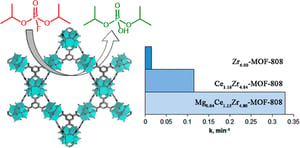 A series of Ce/Zr mixed-metal–organic frameworks with different topology/connectivity, namely, Ce/Zr-UiO-66 (U01, U02, and U03) (fcu (12-c)), Ce/Zr-DUT-67-PZDC (D01 and D02) (reo (8-c)), and Ce/Zr-MOF-808 (M01, M02, and M03) (spn (6-c)) were evaluated toward the detoxification of toxic nerve agent model diisopropylfluorophosphate (DIFP) at room temperature in unbuffered aqueous solution. Noteworthily, the catalytic rate for P–F bond cleavage increased with increasing Ce/Zr molar ratio. A further increase in catalytic activity can be achieved by Mg(OMe)2 doping of the mixed-metal MOFs as exemplified with M01@Mg(OMe)2 and M02@Mg(OMe)2 systems. The results show that Mg(OMe)2 incorporation into the mesoporous cavities of M01 and M02 give rise to P–F hydrolytic degradation half-lives of nearly 5 and 2 min with 100% degradation of DIFP after 55 and 65 min for M01@Mg(OMe)2 1:2 and M02@Mg(OMe)2 1:4, respectively.
A series of Ce/Zr mixed-metal–organic frameworks with different topology/connectivity, namely, Ce/Zr-UiO-66 (U01, U02, and U03) (fcu (12-c)), Ce/Zr-DUT-67-PZDC (D01 and D02) (reo (8-c)), and Ce/Zr-MOF-808 (M01, M02, and M03) (spn (6-c)) were evaluated toward the detoxification of toxic nerve agent model diisopropylfluorophosphate (DIFP) at room temperature in unbuffered aqueous solution. Noteworthily, the catalytic rate for P–F bond cleavage increased with increasing Ce/Zr molar ratio. A further increase in catalytic activity can be achieved by Mg(OMe)2 doping of the mixed-metal MOFs as exemplified with M01@Mg(OMe)2 and M02@Mg(OMe)2 systems. The results show that Mg(OMe)2 incorporation into the mesoporous cavities of M01 and M02 give rise to P–F hydrolytic degradation half-lives of nearly 5 and 2 min with 100% degradation of DIFP after 55 and 65 min for M01@Mg(OMe)2 1:2 and M02@Mg(OMe)2 1:4, respectively.
Sensors
Ultrafast In Situ Synthesis of Large-Area Conductive Metal–Organic Frameworks on Substrates for Flexible Chemiresistive Sensing
 The widespread use of electrically conductive metal–organic frameworks (EC-MOFs) in high-performance devices is limited by the lack of facile methods for synthesizing large-area thin films on the desired substrates. Herein, we propose a spin-coating interfacial self-assembly approach to in situ synthesize high-quality centimeter-sized copper benzenehexathiol (Cu-BHT) MOFs on diverse substrates in only 5 s. The film thickness (ranging from 5 to 35 nm) and surface morphology can be precisely tuned by controlling the reaction time. The gas sensor based on the 10 nm thick Cu-BHT film exhibits a low limit of detection (0.23 ppm) and high selectivity value (>30) in sensing NH3 at ultralow driving voltages (0.01 V). Moreover, the Cu-BHT films retain their initial sensor performance after 1000 repetitive bending cycles at a bending radius of 3 mm. Density functional theory calculations suggest that Cu2c sites induced by crystal particles on the film surface can improve the sensing performance. This facile and ultrafast approach for in situ synthesis of large-area EC-MOF films on diverse substrates with tunable thickness on a nanometer scale should facilitate application of EC-MOFs in flexible electronic device arrays.
The widespread use of electrically conductive metal–organic frameworks (EC-MOFs) in high-performance devices is limited by the lack of facile methods for synthesizing large-area thin films on the desired substrates. Herein, we propose a spin-coating interfacial self-assembly approach to in situ synthesize high-quality centimeter-sized copper benzenehexathiol (Cu-BHT) MOFs on diverse substrates in only 5 s. The film thickness (ranging from 5 to 35 nm) and surface morphology can be precisely tuned by controlling the reaction time. The gas sensor based on the 10 nm thick Cu-BHT film exhibits a low limit of detection (0.23 ppm) and high selectivity value (>30) in sensing NH3 at ultralow driving voltages (0.01 V). Moreover, the Cu-BHT films retain their initial sensor performance after 1000 repetitive bending cycles at a bending radius of 3 mm. Density functional theory calculations suggest that Cu2c sites induced by crystal particles on the film surface can improve the sensing performance. This facile and ultrafast approach for in situ synthesis of large-area EC-MOF films on diverse substrates with tunable thickness on a nanometer scale should facilitate application of EC-MOFs in flexible electronic device arrays.
Luminescent sensing of nitroaromatics by crystalline porous materials
Porous crystalline materials (PCMs) constitute a class of covalent or supramolecular coordination architectures having intensive application in the fields of sensing, gas separation and storage, catalysis and optoelectronic device engineering. The theoretical investigations on these porous crystalline systems using multiple wave functions add fundamental insights into better understanding of highly selective sensing. A lot of recent reports focus on various archetypal luminescent porous organic frameworks, like metal organic frameworks (MOFs), covalent organic frameworks (COFs), or nanocomposites having excellent luminescence sensing performance against a plethora of nitroaromatic compounds and explosives. These exceptional classes of compounds display unique characteristic photochromism and electronic properties which can be tuned from the grass-root level by modifying metal–ligand interactions and various supramolecular interactions at the molecular level. Thus, developing luminescent porous organic frameworks having ultra-fast capacity of sensing nitroaromatic compounds and explosives reversibly with high selectivity and low limits of detection (LOD) is urgently required for national security, as well as homeland and environment safety. The reusability of these porous frameworks can only be anticipated if the crystallinity of these materials is retained after repeated use followed by construction of these frameworks with cheaper starting materials. The present review mainly encompasses the recent progress in various luminescent PCMs incorporating transition metals, lanthanides, nanocomposites, and main group elements having sensing technology applications along with the theoretical insights and possible mechanisms behind “turn-on” or “turn-off” luminescence.
MOF catalysts
Application of Metal–Organic Framework Materials and Derived Porous Carbon Materials in Catalytic Hydrogenation
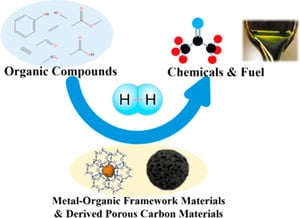 In the past few decades, metal–organic frameworks (MOFs) have gradually become attractive materials in various fields due to their unique properties (adjustable pore size, large specific surface area, highly ordered structure, uniformly distributed metal nodes, good modifiability). MOF-derived porous carbon materials have also attracted great interest in many application fields due to their adjustable chemical and physical properties. The hydrogenation reaction is an important type of reaction in the chemical industry. The catalysts play an important role in the hydrogenation reaction. In recent years, MOFs and derived porous carbon materials have had extensive application in catalytic hydrogenation reactions. Compared with other traditional catalysts, MOFs and derived porous carbon materials have some unique advantages as hydrogenation catalysts, which are described in this review. In addition, we have expounded the rational design of MOF hydrogenation catalysts from the following four aspects: choosing suitable MOFs with coordinated unsaturated metal sites, good stability, and precise control and optimizing the structure of MOF materials and hydrogen storage characteristics of MOF materials. The application of nitrogen-doped carbon materials and MOF-derived porous carbon materials in hydrogenation reactions has also been compared. Moreover, various MOFs and derived porous carbon materials with excellent performance are discussed in detail in various catalytic hydrogenation reactions including olefins, alkynes, alcohols and phenols, aldehydes, carboxylic acids, esters, nitro compounds, and other hydrogenation reactions. Finally, the challenges of MOFs and derived porous carbon materials as hydrogenation catalysts are objectively summarized, and the application and development trends in catalytic hydrogenation reactions are prospected.
In the past few decades, metal–organic frameworks (MOFs) have gradually become attractive materials in various fields due to their unique properties (adjustable pore size, large specific surface area, highly ordered structure, uniformly distributed metal nodes, good modifiability). MOF-derived porous carbon materials have also attracted great interest in many application fields due to their adjustable chemical and physical properties. The hydrogenation reaction is an important type of reaction in the chemical industry. The catalysts play an important role in the hydrogenation reaction. In recent years, MOFs and derived porous carbon materials have had extensive application in catalytic hydrogenation reactions. Compared with other traditional catalysts, MOFs and derived porous carbon materials have some unique advantages as hydrogenation catalysts, which are described in this review. In addition, we have expounded the rational design of MOF hydrogenation catalysts from the following four aspects: choosing suitable MOFs with coordinated unsaturated metal sites, good stability, and precise control and optimizing the structure of MOF materials and hydrogen storage characteristics of MOF materials. The application of nitrogen-doped carbon materials and MOF-derived porous carbon materials in hydrogenation reactions has also been compared. Moreover, various MOFs and derived porous carbon materials with excellent performance are discussed in detail in various catalytic hydrogenation reactions including olefins, alkynes, alcohols and phenols, aldehydes, carboxylic acids, esters, nitro compounds, and other hydrogenation reactions. Finally, the challenges of MOFs and derived porous carbon materials as hydrogenation catalysts are objectively summarized, and the application and development trends in catalytic hydrogenation reactions are prospected.
The applications and prospects of hydrophobic metal–organic frameworks in catalysis
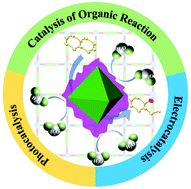 In recent years, large numbers of hydrophobic/superhydrophobic metal–organic frameworks (MOFs) have been developed. These hydrophobic MOFs not only retain rich structural variety, highly crystalline frameworks, and uniform micropores, but they also have lower affinity towards water and boosted hydrolytic stability. Until now, there were two main strategies to prepare hydrophobic MOFs, including a one-step method and post-synthesis modification (PSM). PSM was an often-used strategy for preparing hydrophobic MOFs. Hydrophobic MOFs showed unique advantages when used as catalysts for various categories of reactions. Herein, recent research advances relating to hydrophobic MOFs in the catalytic field are presented. The catalytic activities of hydrophobic MOFs and corresponding hydrophilic ones are also compared, and the superiority of hydrophobic MOFs or MOF materials as catalysts in 10 reactions is discussed. Finally, the advantages of hydrophobic MOFs as catalysts or auxiliary materials are summarized and promising future developments of hydrophobic MOFs are highlighted.
In recent years, large numbers of hydrophobic/superhydrophobic metal–organic frameworks (MOFs) have been developed. These hydrophobic MOFs not only retain rich structural variety, highly crystalline frameworks, and uniform micropores, but they also have lower affinity towards water and boosted hydrolytic stability. Until now, there were two main strategies to prepare hydrophobic MOFs, including a one-step method and post-synthesis modification (PSM). PSM was an often-used strategy for preparing hydrophobic MOFs. Hydrophobic MOFs showed unique advantages when used as catalysts for various categories of reactions. Herein, recent research advances relating to hydrophobic MOFs in the catalytic field are presented. The catalytic activities of hydrophobic MOFs and corresponding hydrophilic ones are also compared, and the superiority of hydrophobic MOFs or MOF materials as catalysts in 10 reactions is discussed. Finally, the advantages of hydrophobic MOFs as catalysts or auxiliary materials are summarized and promising future developments of hydrophobic MOFs are highlighted.
Structure-dependent iron-based metal–organic frameworks for selective CO2-to-CH4 photocatalytic reduction
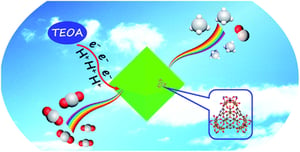 Visible-light driven reduction of carbon dioxide (CO2) to methane (CH4) is a challenge in the photocatalytic reaction system. Herein, two Fe-based metal–organic frameworks (MOFs) MIL-100(Fe) and MIL-101(Fe) with single-trimetallic clusters but distinct organic ligands were employed to explore the structure-dependent CO2 conversion performance. Compared with MIL-101(Fe), MIL-100(Fe) exhibits superior catalytic activity and selectivity for CH4 generation under visible-light irradiation via a solvent-free route. This is the first report that MIL-100(Fe) finishes the photoreduction of CO2 into CH4. Importantly, the plausible conversion pathways of the reaction were given by density functional theory (DFT) calculations. This work furnishes new direction for constructing MOFs to achieve CO2-to-CH4 conversion.
Visible-light driven reduction of carbon dioxide (CO2) to methane (CH4) is a challenge in the photocatalytic reaction system. Herein, two Fe-based metal–organic frameworks (MOFs) MIL-100(Fe) and MIL-101(Fe) with single-trimetallic clusters but distinct organic ligands were employed to explore the structure-dependent CO2 conversion performance. Compared with MIL-101(Fe), MIL-100(Fe) exhibits superior catalytic activity and selectivity for CH4 generation under visible-light irradiation via a solvent-free route. This is the first report that MIL-100(Fe) finishes the photoreduction of CO2 into CH4. Importantly, the plausible conversion pathways of the reaction were given by density functional theory (DFT) calculations. This work furnishes new direction for constructing MOFs to achieve CO2-to-CH4 conversion.
Other publications
Blue Luminescent N,S-doped Carbon Dots Encapsulated in Red Emissive Eu-MOF to Form Dually Emissive Composite for Reversible Anti-counterfeit Ink
Lanthanide metal−organic frameworks (Ln-MOFs) have demonstrated a great potential in luminescence sensing and optical anti-counterfeiting. The high-security anti-counterfeiting technology is of great importance that requires the development of universal luminescent materials with multiple modes emission and adjustable photoluminescence. Herein, a 3D red light emission microporous europium (Ⅲ) metal-organic framework [Eu3(OH)(1,3-db)2(H2O)4]·3H2O (1) (1,3-db=1,3-di(3',5'-dicarboxylpheny) benzene) was constructed by zigzag [Eu3(COO)8] chain and π-electron-rich terphenyl-tetracarboxylate. Notably, the quenched fluorescence of 1 under hydrogen chloride vapor could be recovered upon fumed by vapor of Et3N. Most strikingly, the strong blue light emission nitrogen and sulfur co-doped carbon dots (N,S-CDs) could be encapsulated in 1 to generate dual-emission composite, namely, N,S-CDs@Eu-MOF, which shows solvent dependent photoluminescence: N,S-CDs related blue luminescence in water and Eu-MOF related red emission in organic solvents. Taking advantages of the above unique reversible fluorescent behavior, Eu-MOF and N,S-CDs@Eu-MOF is prepared as fluorescent high-security inks for achieving data encryption and decryption on specific flower patterns.
Calcium‐Based Metal–Organic Frameworks and Their Potential Applications
Metal–organic frameworks (MOFs) built on calcium metal (Ca‐MOFs) represent a unique subclass of MOFs featuring high stability, low toxicity, and relatively low density. Ca‐MOFs show considerable potential for molecular separations, electronic, magnetic, and biomedical applications, although they are not investigated as extensively as transition metal‐based MOFs. Compared to MOFs made of other groups of metals, Ca‐MOFs may be particularly advantageous for certain applications such as adsorption and storage of light molecules because of their gravimetric benefit, and drug delivery due to their high biocompatibility. This review intends to provide an overview on the recent development of Ca‐MOFs, including their synthesis, crystal structures, important properties, and related applications. Various synthetic methods and techniques, types of building blocks, structure and porosity features, selected physical properties, and potential uses will be discussed and summarized. Representative examples will be illustrated for each type of important applications with a focus on their structure–property relations.
Introducing reticular chemistry into agrochemistry
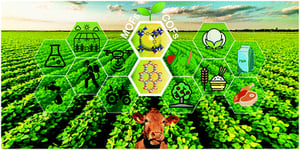 For survival and quality of life, human society has sought more productive, precise, and sustainable agriculture. Agrochemistry, which solves farming issues in a chemical manner, is the core engine that drives the evolution of modern agriculture. To date, agrochemistry has utilized chemical technologies in the form of pesticides, fertilizers, veterinary drugs and various functional materials to meet fundamental demands from human society, while increasing the socio-ecological consequences due to inefficient use. Thus, more useful, precise, and designable scaffolding materials are required to support sustainable agrochemistry. Reticular chemistry, which weaves molecular units into frameworks, has been applied in many fields based on two cutting-edge porous framework materials, namely metal–organic frameworks (MOFs) and covalent-organic frameworks (COFs). With flexibility in composition, structure, and pore chemistry, MOFs and COFs have shown increasing functionalities associated with agrochemistry in the last decade, potentially introducing reticular chemistry as a highly accessible chemical toolbox into agrochemical technologies. In this critical review, we will demonstrate how reticular chemistry shapes the future of agrochemistry in the fields of farm sensing, agro-ecological preservation and reutilization, agrochemical formulations, smart indoor farming, agrobiotechnology, and beyond.
For survival and quality of life, human society has sought more productive, precise, and sustainable agriculture. Agrochemistry, which solves farming issues in a chemical manner, is the core engine that drives the evolution of modern agriculture. To date, agrochemistry has utilized chemical technologies in the form of pesticides, fertilizers, veterinary drugs and various functional materials to meet fundamental demands from human society, while increasing the socio-ecological consequences due to inefficient use. Thus, more useful, precise, and designable scaffolding materials are required to support sustainable agrochemistry. Reticular chemistry, which weaves molecular units into frameworks, has been applied in many fields based on two cutting-edge porous framework materials, namely metal–organic frameworks (MOFs) and covalent-organic frameworks (COFs). With flexibility in composition, structure, and pore chemistry, MOFs and COFs have shown increasing functionalities associated with agrochemistry in the last decade, potentially introducing reticular chemistry as a highly accessible chemical toolbox into agrochemical technologies. In this critical review, we will demonstrate how reticular chemistry shapes the future of agrochemistry in the fields of farm sensing, agro-ecological preservation and reutilization, agrochemical formulations, smart indoor farming, agrobiotechnology, and beyond.





.jpg)
